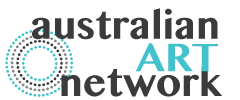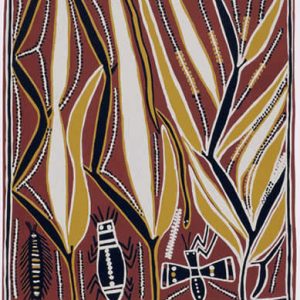David Malangi

Aboriginal artist David Malangi was born in 1927 and for most of his life he lived with his extended family at Yathalamara in the Northern Territory. He was the head of the Manarrngu clan and one of the most powerful elders of central Arnhem Land. With the death of clan leaders who owned adjacent lands, Malangi inherited custodianship for vast tracts of land on either side of the Goyder River, thus inheriting the associated responsibilities for caring for sacred sites, recounting the journeys of both the Djankawau creation ancestors and of the ancestor Gunmirringu.
He began bark painting as a young boy, taught by his father and uncle to paint on bodies for ceremonies, on hollow logs for burials and later on stringybark. He was taught to paint the story of his creation ancestor, Gurrumurringu, and the story of the Djangkawu sisters. David painted the stories that they sang in their ceremonies and his totems the sea eagle, crow, snake and goanna.
Malangi recalled: ‘I saw my father paint dead men’s (bodies) when I was a little boy and I copied’.
In 1966, when Australia adopted decimal currency, the central motif of the original dollar note was a direct representation of the Gunmirringu story from one of David Malangi’s bark paintings. The artist knew nothing of this until he saw the note. The Reserve Bank later recognized his copyright and awarded him compensation and so began the recognition of Aboriginal art copyright.
David Malangi was a prolific and highly individualistic Aboriginal artist whose bark paintings and fine art prints has been sought after by major international collectors since the 1960’s. In style, his bold collection of individual imagery and shapes on a clear, red ochre or sometimes black background influenced several other central Arnhem Land painters.
He usually composed his paintings and prints around vertical lines rather than a central circular image as favoured by most Central Arnhem Land painters, and used broader, bolder brushmarks.
His strong, graphic art works, often thickly outlined in white, return to particular themes, always in differing formations with a high figurative content.
His bark paintings and limited edition prints are in collections in Australia and abroad, and took him to Australia’s state capitals, New York and Tahiti.
David Malangi was one of the artists who participated in a series of workshops in Ramingining, held by printmaker Theo Tremblay, during which they produced an important series of limited edition prints, the Raminging Print Suite, based on the Wagilag Sisters creation story. This workshop represents a unique collaboration by a group of celebrated Aboriginal artists.
In 1996 he was awarded an honorary Doctorate of Law by the Australian National University for his “distinguished creative contribution in the service of society.” He was artist in residence at Flinders University (1982) and Sydney University (1983) and in 1988 was invited to the opening of the ‘Dreamings’ exhibition at the Asia Society Galleries in New York.
Subject & Themes
Gunmirringu, the great hunter (mortuary),Yathalmarra-Arafura Swamp, white cockatoos (mortuary), file snakes, dharrpa -king brown snake, Coomeringero Creation Spirit, Long necked turtles.
Collections
Arnotts Collection, Sydney.
Artbank, Sydney.
Art Gallery of New South Wales, Sydney.
Art Gallery of Queensland, Brisbane.
Art Gallery of South Australia, Adelaide.
Art Gallery of Western Australia, Perth.
Australian Museum, Sydney.
Berndt Museum of Anthropology, University of Western Australia.
Central Collection, Australian National University, Canberra.
Flinders University Art Museum, Adelaide.
Gold Coast City Art Gallery, Surfers Paradise, Queensland.Karel Kupta Collection.
Linden Museum, Stuttgart, Germany.
Milingimbi Collection, MECA, Milingimbi Educational and Cultural Association.
Musee des Arts Africans et Oceaniens, Paris, France.
Museum and Art Gallery of the Northern Territory, Darwin.
Ramingining Collection, Sydney. Museum of Contemporary Art.
Museum of Victoria, Melbourne.Myer Gatner Collection.
National Gallery of Australia, Canberra.
National Gallery of Victoria, Melbourne.
National Maritime Museum, Darling Harbour, Sydney.
Reserve Bank CollectionRobert Holmes a Court Collection.
South Australian Museum, Adelaide.
Tasmanian Museum and Art Gallery, Horsfall Collection, Hobart.
University of QueenslandAnthropology Museum, St Lucia.
Individual Exhibitions
1986 State Bank of NSW, Sydney (arranged through Macquarie Galleries)
Group Exhibitions
1966 Bark Paintings from Arnhem Land, Museum of Art, The University of Kansas, USA.
1969 Australian Aboriginal Art – The Louis A. Allen Collection, R. H. Lowie Museum of Anthropology, University of California, Berkeley, USA.
1969 Australie, Osobnost Primitivni’ho Malire, Naprstkovo Muzeum, African and American Culture, Prague.
1972 Australian Aboriginal Art, Field Museum of Natural History, Chicago, USA.
1974 Australian Aboriginal Art from the Louis A. Allen Collection, M. H. de Young Memorial Museum, California Palace of the Legion of Honor, USA.
1974 Art of the Dreamtime, The Bennett Collection of Australian Aboriginal Art, Adelaide Festival of Arts, Art Gallery of South Australia, Adelaide.
1974 to 1976, Art of Aboriginal Australia, touring Canada, Rothmans of Pall Mall Canada Ltd.
1975 Australian Bark Painting, from the collection of Dr. Edward L. Ruhe, Meadow Brook Art Gallery, Oakland University, Rochester, Michigan, USA.
1979 European Dialogue, Biennale of Sydney, Art Gallery of New South Wales, Sydney.
1983 Australian Perspecta, Art Gallery of New South Wales, Sydney.
1983 XVII Bienal de Sao Paulo, Sao Paulo, Brazil.
1984 Objects & Representations from Ramingining, Power Institute [now MCA], Sydney.
1986 Ramingining Art Exhibition, Araluen Arts Centre, Alice Springs, NT.
1986 The Art of the First Australians, Kobe City Museum, Japan.
1986 The Third National Aboriginal Art Award Exhibition, Museum and Art Gallery of the Northern Territory, Darwin.
1987 Ancestors and Spirits, National Gallery of Australia, Canberra.
1988 Dreamings, the art of Aboriginal Australia, Asia Society Galleries, New York.
1989 Aboriginal Art: The Continuing Tradition, National Gallery of Australia, Canberra.
1990 l’ete Australien a’ Montpellier, Musee Fabre Gallery, Montpellier, France.
1990 Spirit in Land, Bark Paintings from Arnhem Land, National Gallery of Victoria.
1990 Keepers of the Secrets, Aboriginal Art from Arnhemland, Art Gallery of Western Australia, Perth.
1991 Canvas and Bark, South Australian Museum, Adelaide.
1992 The Ninth National Aboriginal Art Award Exhibition, Museum and Art Gallery of the Northern Territory, Darwin.
1992 Crossroads-Towards a New Reality, Aboriginal Art from Australia, National Museums of Modern Art, Kyoto and Tokyo.
1992/3 New Tracks Old Land: An Exhibition of Contemporary Prints from Aboriginal Australia, touring USA and Australia.
1993 Ten years of acquisitions,from ANU collection, Drill Hall Gallery ACT.
1993 Arnhem Land Dreaming, Bark Paintings from Tasmanian Collections, Tasmanian Museum and Art Gallery.
1993/4 ARATJARA, Art of the First Australians, Touring: Kunstammlung Nordrhein-Westfalen, Dusseldorf; Hayward Gallery, London; Louisiana Museum, Humlebaek, Denmark.
1994 Milminydjarrk, sand sculpture & dance, Tandanya, Adelaide Festival, SA.
1994 Power of the Land, Masterpieces of Aboriginal Art, National Gallery of Victoria.
1994 The Eleventh National Aboriginal Art Award Exhibition, Museum and Art Gallery of the Northern Territory, Darwin.
1994 Australian Heritage Commission National Aboriginal and Torres Strait Islander Art Award Exhibition, Old Parliament House, Canberra.
1994 Yiribana, Art Gallery of New South Wales, Sydney.
1994 Malu Urul, National Maritime Museum, Sydney.
1995 The Twelfth National Aboriginal Art Award, Museum and Art Gallery of the Northern Territory, Darwin.
1995 Galerie des Five Continents, Musee des Arts Africans et Oceaniens, Paris, France.
1995 In the Time before Morning: Aboriginal Art Jim Davidson collection National Gallery of Victoria, Melbourne Vic.
1995 12th NATSI Art Award Museum & Art Galleries of NT, Darwin.
1997 Juxtapositions: an exhibition of Australian Indigenous works Flinders University Art Museum, Adelaide.
1998 15th NATSI Art Award Museum & Art Galleries of NT, Darwin.
1999 Myer Gatner Collection, Los Angeles USA.
1999 Claiming Title Australian Aboriginal Artists and Their Land, Carelton College, Minnesota, USA.
Bibliography
Allen, L., 1975, Time Before Morning: Art and Myth of the Australian Aborigines, Thomas Crowell Company, New York.
Bennett, D.H., 1980, ‘Malangi: the man who was forgotten before he was remembered,’ Aboriginal History 4 (1) 43-47. (C)
Beresford, A., 1993, Arnhem Land Dreaming, Bark Paintings from Tasmanian Collections, exhib. cat. Tasmanian Museum and Art Gallery.
Berndt, R. M. and Berndt, C. H. with Stanton, J., 1982, Aboriginal Australian Art, a Visual Perspective, Methuen Australia Pty Ltd, Sydney.
Caruana, W., 1987, Australian Aboriginal Art, a Souvenir Book of Aboriginal Art in the Australian National Gallery, Australian National Gallery, Parkes, Australian Capital Territory. (C)
Caruana, W. (ed.), 1989, Windows on the Dreaming, Ellsyd Press, Sydney. (C)
Caruana, W., 1993, Aboriginal Art, Thames and Hudson, London. (C)
Chanin, E., 1990, (ed.), Contemporary Australian Painting, Craftsman House, Roseville, NSW, Australia.
Crossman, S. and Barou, J-P. (eds), 1990, L’ete Australien a Montpellier: 100 Chefs d’Oevre de la Peinture Australienne, Musee Fabre, Montpellier, France. (C)
Dussart, F., 1993, La Peinture des Aborigines D’Australie, Editions Parentheses, Marseille, France.
Groger-Wurm, H., 1973, Australian Aboriginal Paintings and their Mythological Interpretation, Australian Institute of Aboriginal Studies, Canberra. (C)
Hill, M., and McLeod, N.,1984, From the Ochres of Mungo, Aboriginal Art Today, Dorr McLeod Publishing, West Heidleberg, Victoria. (C)
Isaacs, J., 1984, Australia’s Living Heritage, Arts of the Dreaming, Lansdowne Press, Sydney. (C)
Isaacs J. Spirit Country: Contemporary Australian Aboriginal Art. Hardie Grant Books. Fine Arts Museum of San Francisco 1999.
Morphy H. Aboriginal Art Phaidon Press 1998.
Art from the Land: Dialogues with the Kluge-Ruhe Collection of Australian Aboriginal Art ed. by Howard Morphy and Margo Smith. University of Virginia Press 1999.
McCulloch, S. Contemporary Aboriginal Art: a guide to the rebirth of an ancient culture Allen & Unwin 1999.
Artlink: Reconciliation? Indigenous Art for the 21st Century Vol 20,2000.
The Native Born:Objects and Representations from Ramingining Arnhem Land ed. by Bernice Murphy MCA in association with Bula Bula Arts, Ramingining.v Claiming Title Australian Aboriginal Artists and Their Land, catalogue 1999 Carelton College Minnesota, USA
Showing the single result

